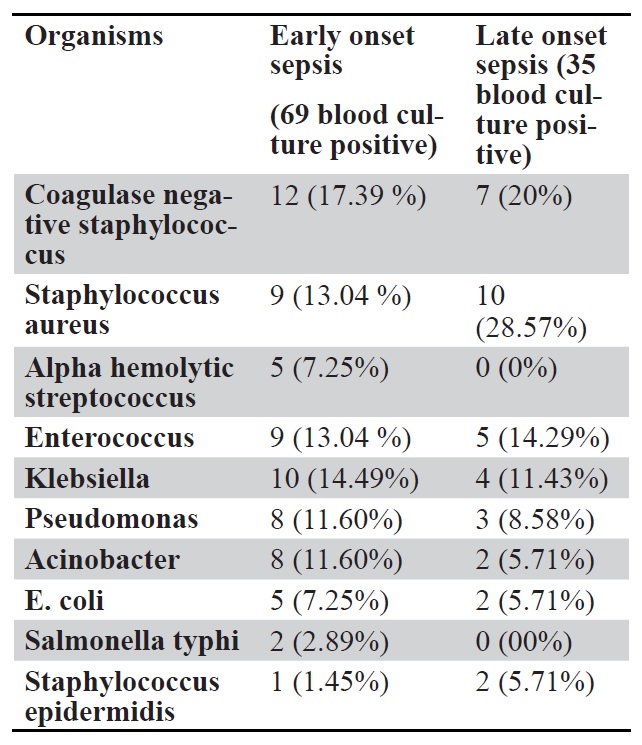Correlation between C - Reactive Protein and Blood Culture in Neonatal Sepsis at a Tertiary Care Centre in Western Nepal
DOI:
https://doi.org/10.22502/jlmc.v7i2.286Keywords:
Blood culture, C- Reactive protein, Neonatal intensive care unit, Neonatal sepsisAbstract
Introduction: Neonatal sepsis is a serious problem that needs to be addressed for a better outcome of the neonates. This study was conducted to determine the sensitivity, specificity, positive predictive value (PPV) and negative predictive value (NPV) of C-Reactive Protein (CRP) in neonates with sepsis in comparison with blood culture. Methods: This cross-sectional study was carried out in clinically suspected neonates with sepsis in a tertiary hospital. Association between C-reactive protein and blood culture positivity in neonatal sepsis was studied. Results: Out of 245 patients admitted with clinical suspicion of sepsis, 104 (42.45%, 95% CI: 36.18-48.90%) were blood culture-proven sepsis. CRP was reactive in 92 cases (88.5%, 95% CI: 80.71 % - 93.89%) of blood culture-proven sepsis. Gram-negative organisms were predominant, 58 (57.55%) seen from the isolates of blood culture while gram-positive organisms were found to be 46 (43.23%). Early-onset sepsis was seen in 194 (79.18%) cases, while late-onset sepsis accounted for 51(20.82%). The sensitivity and specificity of CRP in the diagnosis of neonatal sepsis was 88.5% and 46.1% respectively with the positive predictive value of 54.8% and negative predictive value of 84.1% and diagnostic accuracy of 64.1%. Conclusion: Neonatal sepsis is still an important cause of hospital admission in the neonatal intensive care unit of our hospital. This study highlights the high sensitivity and negative predictive value but lower specificity and positive predictive value of CRP in relation to blood culture. The present study depicts a significant correlation between culture positivity and CRP.
Downloads
References
Zea-Vera A, Ochoa TJ. Challenges in the Diagnosis and Management of Neonatal Sepsis. Journal of Tropical Pediatrics. 2015;61(1):1-13. doi:https://doi.org/10.1093/tropej/fmu079
Khanal R, Manandhar S, Acharya GP. Bacteriological Profile of Neonatal Sepsis in a Tertiary Level Hospital of Nepal. Journal of Nepal Paediatric Society. 2014;34(3):175-180. DOI: https://doi.org/10.3126/jnps.v34i3.9183
Kumar B. Evaluation of Serum C-Reactive Protein in Diagnosis and Prognosis of Neonatal Septicemia. Webmed Central Pediatrics.2013;4(7):WMC001643. Available from: http://www.webmedcentral.com/article_ view/1643
Sugimoto K, Adomi S, Koike H, Esa A. Procalcitonin as an indicator of urosepsis. Research and Reports in Urology. 2013;26(5):77- 80. DOI: https://doi.org/10.2147/RRU.S42711. PMID: 24400237.
Hisamuddin E, Hisam A, Wahid S, Raza G. Validity of C-reactive protein (CRP) for diagnosis of neonatal sepsis. Pakistan Journal of Medical Sciences. 2015;31(3):527–31. DOI: https://doi.org/10.12669/pjms.313.6668.PMID: 26150837
Trivedi R, Amer A, Patel R, Trivedi P. Comparison of a Rapid Semi-Quantitative Latex Agglutination Slide Method Against Quantitative Particle Enhanced Turbidimetric Immunoassay for Measurement of C-ReactiveProtein. International Journal of Medical and Biomedical Sciences. 2019;3(5):190-95. DOI: https://doi. org/10.32553/ijmbs.v3i5.265
Kleigman R, Stanton B, St.Geme J, Schor N, Behrman R, Nelson W. Nelson Textbook of Pediatrics. Philadelphia: Elsevier; 2016.P.517
Thakur S, Thakur K, Sood A, Chaudhary S. Bacteriological Profile and Antibiotic Sensitivity Pattern of Neonatal Septicemia in a Rural Tertiary Care Hospital in North India. Indian Journal of Medical Microbiology. 2016;34(1):67-71. DOI: https://doi.org/10.4103/0255-0857.174108. PMID: 26776121
Rawat A, Shukla OS. Haemato-bacteriological profile and antibiogram of suspected cases of early-onset sepsis in very low birth weight neonates. Sri Lanka Journal of Child Health. 2019;48(1):59-64 DOI: http://dx.doi.org/10.4038/ sljch.v48i1.8654
Bhatia, S, Verma CR, Tomar BS, Natani BS, Goyal P, Agarwal A. Correlation of CRP and
Blood Culture in the evaluation of Neonatal Sepsis. Indian Journal of Basic and Applied Medical Research.2016;6(1): 663-70
Kumar R, Deka A, Choudhury SN, Roy M. C-reactive protein—As an early diagnostic marker of early onset sepsis and its correlation with blood culture. The New Indian Journal of OBGYN. 2016;2(2):78-82. Available from: http://journal.barpetaogs.co.in/pdf/0278.pdf
Galhotra S, Gupta V, Chhina D, Bains HS, Chhabra A. Comparative utility of C reactive protein and Blood culture for diagnosis of neonatal septicemia. International Journal of Research and Development in Pharmacy and Life Science. 2017;6(2): 2586-2589. DOI: http:// dx.doi.org/10.21276/IJRDPL 2278.0238.
Lakhey A& Shakya H. Role of sepsis screening in early diagnosis of neonatal sepsis. Journal of Pathology of Nepal. 2017;7(1):1103-10. DOI: https://doi.org/10.3126/jpn.v7i1.16944
Mishra D, Chapagain RH, Bhattarai S, Jha NK, Mishra R. Clinico-pathological Profile of Late-Onset Neonatal Sepsis in a Tertiary Centre of Nepal. Medical Journal of Shree Birendra Hospital. 2019;18(2):2-6. DOI:https://doi. org/10.3126/mjsbh.v18i2.23517
Chapagain RH, Acharya R, Shrestha N, Giri BR, Bagale BB, Kayastha M. Bacteriological Profile of Neonatal Sepsis in Neonatal Intermediate Care Unit of Central Paediatric Referral Hospital in Nepal. Journal of Nepal Health Research Council. 2015; 13(3):205-8. doi:https://doi. org/10.33314/jnhrc.v0i0.673
Randis TM, Rice MM, Myatt L, Tita ATN, Leveno KJ, Reddy UM et al. Incidence of early-onset sepsis in infants born to women with clinical Chorioamnionitis. Journal of Perinatal Medicine. 2018;46(8):926-33 DOI: .https://doi. org/10.1515/jpm-2017-0192
Mendoza-Palomar N, Balasch-Carulla M, González-Di Lauro S, Céspedes MC, Andreu A, Frick MA et al. Escherichia coli early-onset sepsis: trends over two decades. European Journal of Pediatrics. 2017;176(9):1227-34. DOI: https://doi.org/10.1007/s00431-017-2975-z
Shivanna V, Sunkappa SR, Venkatesha D. The rising trend of coagulase-negative staphylococci in neonatal septicemia. Indian Journal of Pathology and Microbiology. 2016;59(4):510- 12. Available from: http://www.ijpmonline.org/ text.asp?2016/59/4/510/191806
Roy I, Jain A, Kumar M, Agarwal SK. Bacteriology of neonatal septicemia in a tertiary care hospital of Northern India. Indian Journal of Medical Microbiology. 2002;20(3):156-159. PMID: 17657057
Afsharpaiman S, Torkaman M, Saburi A, Farzaampur A, Amirsalari S, Kavehmanesh Z. Trends in the incidence of neonatal sepsis and antibiotic susceptibility of causative agents in two neonatal intensive care units in Tehran, I.R Iran. Journal of Clinical Neonatology. 2012;1(3):124-130.Available from http://www. jcnonweb.com/text.asp?2012/1/3/124/101692
El-Sonbaty M, AlSharany W, Youness ER, Mohamed NA, Abdel-Hamid TA, Abdel- Razek ARA. Diagnostic utility of biomarkers in the diagnosis of early stages of neonatal sepsis in the neonatal intensive care unit in Egypt. Egyptian Pediatric Association Gazette.2016;64(2):,91–96 DOI: https://doi.org/10.1016/j.epag.2016.01.002
Brown JVE, Meader N, Cleminson J, Mc Guire W. C- reactive protein for diagnosing late-onset infection in newborn infants. Cochrane Database of Systematic Reviews 2019, Issue 1. Art No.: CD012126. doi: 10.1002/14651858. CD012126.pub2.
Lim WH, Lien R, Huang Y-C, Chiang MC, Fu R-H, Chu S-M, et al. Prevalence and Pathogen Distribution of Neonatal Sepsis Among Very- low-birth-weight Infants. Pediatrics and Neonatology. 2012;53(4):228–34. DOI: https:// doi.org/10.1016/j.pedneo.2012.06.003
Saeed T, Zahoor-Ul-Haq M, Subhani F, Zulfiqar R, Raja TM. C-Reactive Protein (CRP) Levels in Early Diagnosis of Neonatal Sepsis. Journal of Rawalpindi Medical College. 2014;18(1).
Saboohi E, Saeed F, Khan RN, Khan MA. Immature to total neutrophil ratio as an early indicator of early neonatal sepsis. Pakistan Journal of Medical Sciences. 2019;35(1):241- 46. DOI: https://doi.org/10.12669/pjms.35.1.99

Downloads
Published
Issue
Section
License
- The Journal of Lumbini Medical College (JLMC) publishes open access articles under the terms of the Creative Commons Attribution (CC BY) License which permits use, distribution and reproduction in any medium, provided the original work is properly cited.
- JLMC requires an exclusive licence to publish the article first in its journal in print and online.
- The corresponding author should read and agree to the following statement before submission of the manuscript for publication,
- License agreement
- In submitting an article to Journal of Lumbini Medical College (JLMC) I certify that:
- I am authorized by my co-authors to enter into these arrangements.
- I warrant, on behalf of myself and my co-authors, that:
- the article is original, has not been formally published in any other peer-reviewed journal, is not under consideration by any other journal and does not infringe any existing copyright or any other third party rights;
- I am/we are the sole author(s) of the article and have full authority to enter into this agreement and in granting rights to JLMC are not in breach of any other obligation;
- the article contains nothing that is unlawful, libellous, or which would, if published, constitute a breach of contract or of confidence or of commitment given to secrecy;
- I/we have taken due care to ensure the integrity of the article. To my/our - and currently accepted scientific - knowledge all statements contained in it purporting to be facts are true and any formula or instruction contained in the article will not, if followed accurately, cause any injury, illness or damage to the user.
- I, and all co-authors, agree that the article, if editorially accepted for publication, shall be licensed under the Creative Commons Attribution License 4.0. If the law requires that the article be published in the public domain, I/we will notify JLMC at the time of submission, and in such cases the article shall be released under the Creative Commons 1.0 Public Domain Dedication waiver. For the avoidance of doubt it is stated that sections 1 and 2 of this license agreement shall apply and prevail regardless of whether the article is published under Creative Commons Attribution License 4.0 or the Creative Commons 1.0 Public Domain Dedication waiver.
- I, and all co-authors, agree that, if the article is editorially accepted for publication in JLMC, data included in the article shall be made available under the Creative Commons 1.0 Public Domain Dedication waiver, unless otherwise stated. For the avoidance of doubt it is stated that sections 1, 2, and 3 of this license agreement shall apply and prevail.
Please visit Creative Commons web page for details of the terms.












